 W
WA rock is any naturally occurring solid mass or aggregate of minerals or mineraloid matter. It is categorized by the minerals included, its chemical composition and the way in which it is formed. Rocks form the Earth's outer solid layer, the crust, and most of its interior, except for the liquid outer core and pockets of magma in the asthenosphere.
 W
WBedrock in geology is solid rock that lies under loose softer material (regolith) within the crust of Earth or another terrestrial planet.
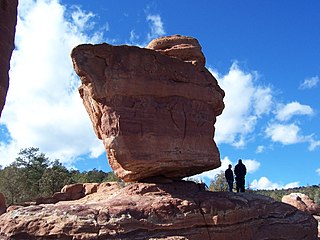 W
WIn geology, a boulder is a rock fragment with size greater than 256 millimetres (10.1 in) in diameter. Smaller pieces are called cobbles and pebbles. While a boulder may be small enough to move or roll manually, others are extremely massive. In common usage, a boulder is too large for a person to move. Smaller boulders are usually just called rocks or stones. The word boulder is short for boulder stone, from Middle English bulderston or Swedish bullersten.
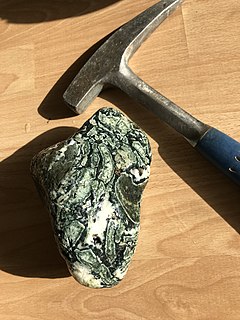 W
WDallasite is a breccia made of subequant to rectangular or distinctly elongate, curvilinear shards that represent the spalled rims of pillow basalt. This material is commonly partly altered to chlorite, epidote, quartz and carbonate, for which the local term 'dallasite' has been coined. The stone dallasite is named after Dallas Road, Victoria, British Columbia. It is considered the unofficial stone of British Columbia's capital city. Dallasite is found in Triassic volcanic rocks of Vancouver Island and is considered the third most important gem material in British Columbia.
 W
WDesert varnish or rock varnish is an orange-yellow to black coating found on exposed rock surfaces in arid environments. Desert varnish is approximately one micrometer thick and exhibits nanometer-scale layering. Rock rust and desert patina are other terms which are also used for the condition, but less often.
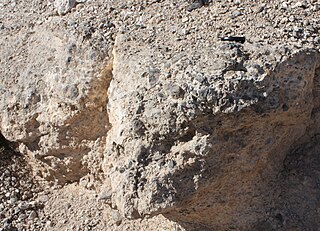 W
WFault breccia, or tectonic breccia, is a breccia that was formed by tectonic forces.
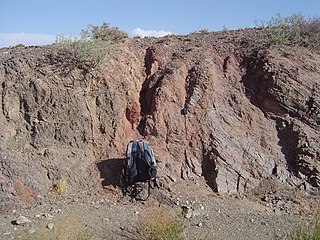 W
WFault gouge is a tectonite with a very small grain size. Fault gouge has no cohesion and it is normally an unconsolidated rock type, unless cementation took place at a later stage. A fault gouge forms in the same way as fault breccia, the latter also having larger clasts. In comparison to fault breccia, which is another incohesive fault rock, fault gouge has a lower volume-fraction of visible fragments. Fault gouge is also classified as have particles that are smaller than 1mm in diameter. Therefore, fault gouge is commonly composed of clays which commonly consist of Illite, Montmorillonite, Saponite, Kaolinite, Vermiculite, Quartz, Chlorite, Muscovite, Biotite, and/or Feldspars.
 W
WA geode is a geological secondary formation within sedimentary and volcanic rocks. Geodes are hollow, vaguely spherical rocks, in which masses of mineral matter are secluded. The crystals are formed by the filling of vesicles in volcanic and sub-volcanic rocks by minerals deposited from hydrothermal fluids; or by the dissolution of syn-genetic concretions and partial filling by the same, or other, minerals precipitated from water, groundwater or hydrothermal fluids.
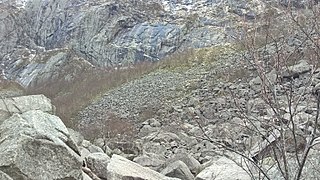 W
WGloppedalsura, or Gloppura, is a scree in Gloppedalen, Rogaland, Norway, in the Gjesdal and Bjerkreim municipalities. It is one of the largest screes in Scandinavia and Northern Europe.
 W
WHoward's Rock is a large piece of quartzite that is displayed in Clemson University's Memorial Stadium. The rock is the center of a longstanding tradition where players touch it before running down the hill in the east end zone at each home football game.
 W
WIntrusive rock is formed when magma penetrates existing rock, crystallizes, and solidifies underground to form intrusions, such as batholiths, dikes, sills, laccoliths, and volcanic necks.
 W
WJasper conglomerate is an informal term for a very distinctive Paleoproterozoic quartz and jasper pebble conglomerate that occurs within the middle part of the Lorrain Formation of the Cobalt Group of the Huronian Supergroup. It is also known by other names including pebble jasper conglomerate, St. Joseph Island puddingstone, Drummond Island puddingstone, Michigan puddingstone. The jasper conglomerate occurs on St. Joseph Island and the St. Mary's River area north and northwest of the Bruce Mines of Northern Ontario, about 65 kilometres (40 mi) east of Sault Ste. Marie. This conglomerate consisted originally of gravelly sands and sandy gravels composed of subrounded pebbles of red jasper, white quartzite, semi-transparent quartz, and black chert, with coarse-grained sand matrix. Typically it contains between about 30% to as much as 90% pebbles. It has been cemented and partially metamorphosed into a quartzitic conglomerate. The beds of jasper conglomerates fill erosional troughs and channels of what are interpreted to be either alluvial fan or braided river deposits of the Lorrain Formation. These deposits are interpreted to represent nonglacial deposits that immediately postdate the Makganyene glaciation.
 W
WLimonite is an iron ore consisting of a mixture of hydrated iron(III) oxide-hydroxides in varying composition. The generic formula is frequently written as FeO(OH)·nH2O, although this is not entirely accurate as the ratio of oxide to hydroxide can vary quite widely. Limonite is one of the three principal iron ores, the others being hematite and magnetite, and has been mined for the production of iron since at least 2500 BCE.
 W
WThis is a list of sea stacks in Scotland.
 W
WMicrobialite is a rock or benthic sedimentary deposit made of carbonate mud that is formed with the mediation of microbes. The constituent carbonate mud is a type of automicrite, or authigenic carbonate mud, and therefore it precipitates in situ instead of being transported and deposited. Being formed in situ, a microbialite can be seen as a type of boundstone where reef builders are microbes, and precipitation of carbonate is biotically induced instead of forming tests, shells or skeletons. Bacteria can precipitate carbonate both in shallow and in deep water and so microbialites can form regardless of the sunlight.
 W
WMohawkite is a rare rock consisting of mixtures of arsenic, silver, nickel, skutterudite and copper, with the formula Cu3As up to Cu6As, and the most desirable material was usually found in white quartz matrix. It has a hardness of 3-3.5 and a metallic luster. It is named after the Mohawk mine where it was originally found. Colors range from brassy-yellow to metallic gray, and sometimes will have a blue or greenish surface tarnish. These colors come from its two main ingredients, the arsenic-rich copper minerals algodonite and domeykite. Its color may resemble pyrrhotite, but unlike pyrrhotite, mohawkite is not magnetic.
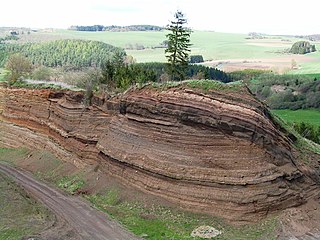 W
WAn outcrop or rocky outcrop is a visible exposure of bedrock or ancient superficial deposits on the surface of the Earth.
 W
WPet Rock is a collectible toy made in 1975 by advertising executive Gary Dahl. Pet Rocks are smooth stones from Mexico's Rosarito Beach. They were marketed like live pets, in custom cardboard boxes, complete with straw and breathing holes. The fad lasted about six months, ending after a short increase in sales during the Christmas season of December 1975. Although by February 1976 they were discounted due to lower sales, Dahl sold over 1 million Pet Rocks for $4 each, and became a millionaire.
 W
WA phenocryst is an early forming, relatively large and usually conspicuous crystal distinctly larger than the grains of the rock groundmass of an igneous rock. Such rocks that have a distinct difference in the size of the crystals are called porphyries, and the adjective porphyritic is used to describe them. Phenocrysts often have euhedral forms, either due to early growth within a magma, or by post-emplacement recrystallization. Normally the term phenocryst is not used unless the crystals are directly observable, which is sometimes stated as greater than .5 millimeter in diameter. Phenocrysts below this level, but still larger than the groundmass crystals, are termed microphenocrysts. Very large phenocrysts are termed megaphenocrysts. Some rocks contain both microphenocrysts and megaphenocrysts. In metamorphic rocks, crystals similar to phenocrysts are called porphyroblasts.
 W
WPounamu or greenstone are terms for several types of hard and durable stone found in southern New Zealand. They are highly valued in New Zealand, and carvings made from pounamu play an important role in Māori culture.
 W
WThe Pulpí Geode is a giant geode found in Spain near the town of Pulpí by Javier Garcia-Guinea of the Grupo Mineralogista de Madrid in December 1999. This geode is one of the larger documented geodes in the world to date. It occupies a space of 10.7 m3 and is located at a depth of 50 m in the Pilar de Jaravía lead mine, in the Sierra del Aguilón, in the municipality of Pulpí, coinciding with the sea level, 3 km from the coast. It has a funnel shape, with the narrowest part being L-shaped. It is notable on a worldwide scale for both its size and the transparency and perfection of the selenite (gypsum) crystals lining the interior, which reach up to 2 m in length, with 0.5 m being the average.
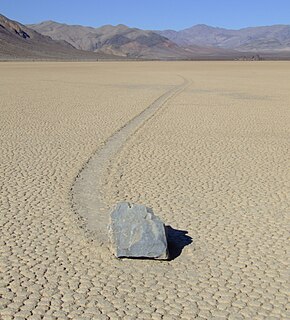 W
WSailing stones are part of the geological phenomenon in which rocks move and inscribe long tracks along a smooth valley floor without animal intervention. The movement of the rocks occurs when large sheets of ice a few millimeters thick and floating in an ephemeral winter pond break up on sunny days. Frozen during cold winter nights, these thin, floating ice panels are driven by wind and shove rocks at speeds up to 5 meters per minute.
 W
WIn geomechanics, a tilt test is a simple test to estimate the shear strength parameters of a discontinuity. Two pieces of rock containing a discontinuity are held in hand or mounted in test equipment with the discontinuity horizontal. The sample is slowly tilted until the top block moves. The angle with the horizontal at onset of movement is called the tilt-angle.
 W
WA ventifact is a rock that has been abraded, pitted, etched, grooved, or polished by wind-driven sand or ice crystals. These geomorphic features are most typically found in arid environments where there is little vegetation to interfere with aeolian particle transport, where there are frequently strong winds, and where there is a steady but not overwhelming supply of sand.
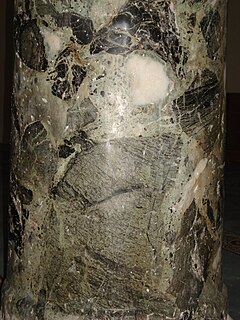 W
WVerd antique, also called verde antique, marmor thessalicum, or Ophite, is a serpentinite breccia popular since ancient times as a decorative facing stone. It is a dark, dull green, white-mottled serpentine, mixed with calcite, dolomite, or magnesite, which takes a high polish. The term verd antique has been documented in English texts as early as 1745.